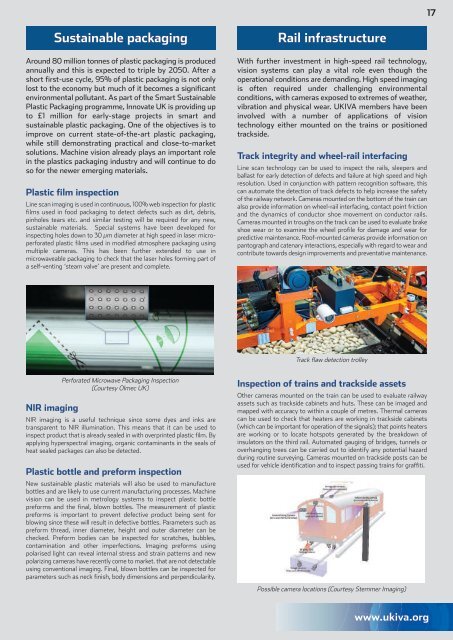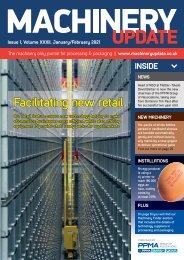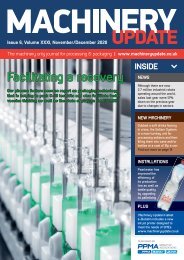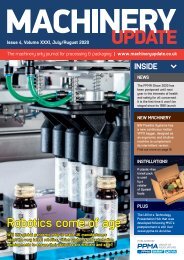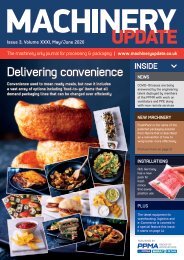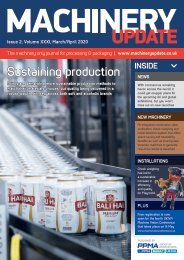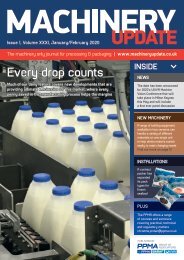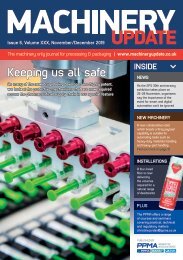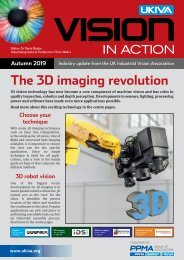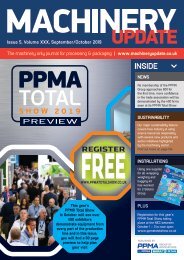Vision in Action 2020
- No tags were found...
You also want an ePaper? Increase the reach of your titles
YUMPU automatically turns print PDFs into web optimized ePapers that Google loves.
17<br />
Susta<strong>in</strong>able packag<strong>in</strong>g<br />
Around 80 million tonnes of plastic packag<strong>in</strong>g is produced<br />
annually and this is expected to triple by 2050. After a<br />
short first-use cycle, 95% of plastic packag<strong>in</strong>g is not only<br />
lost to the economy but much of it becomes a significant<br />
environmental pollutant. As part of the Smart Susta<strong>in</strong>able<br />
Plastic Packag<strong>in</strong>g programme, Innovate UK is provid<strong>in</strong>g up<br />
to £1 million for early-stage projects <strong>in</strong> smart and<br />
susta<strong>in</strong>able plastic packag<strong>in</strong>g. One of the objectives is to<br />
improve on current state-of-the-art plastic packag<strong>in</strong>g,<br />
while still demonstrat<strong>in</strong>g practical and close-to-market<br />
solutions. Mach<strong>in</strong>e vision already plays an important role<br />
<strong>in</strong> the plastics packag<strong>in</strong>g <strong>in</strong>dustry and will cont<strong>in</strong>ue to do<br />
so for the newer emerg<strong>in</strong>g materials.<br />
Plastic film <strong>in</strong>spection<br />
L<strong>in</strong>e scan imag<strong>in</strong>g is used <strong>in</strong> cont<strong>in</strong>uous, 100% web <strong>in</strong>spection for plastic<br />
films used <strong>in</strong> food packag<strong>in</strong>g to detect defects such as dirt, debris,<br />
p<strong>in</strong>holes tears etc. and similar test<strong>in</strong>g will be required for any new,<br />
susta<strong>in</strong>able materials. Special systems have been developed for<br />
<strong>in</strong>spect<strong>in</strong>g holes down to 30 µm diameter at high speed <strong>in</strong> laser microperforated<br />
plastic films used <strong>in</strong> modified atmosphere packag<strong>in</strong>g us<strong>in</strong>g<br />
multiple cameras. This has been further extended to use <strong>in</strong><br />
microwaveable packag<strong>in</strong>g to check that the laser holes form<strong>in</strong>g part of<br />
a self-vent<strong>in</strong>g ‘steam valve’ are present and complete.<br />
Rail <strong>in</strong>frastructure<br />
With further <strong>in</strong>vestment <strong>in</strong> high-speed rail technology,<br />
vision systems can play a vital role even though the<br />
operational conditions are demand<strong>in</strong>g. High speed imag<strong>in</strong>g<br />
is often required under challeng<strong>in</strong>g environmental<br />
conditions, with cameras exposed to extremes of weather,<br />
vibration and physical wear. UKIVA members have been<br />
<strong>in</strong>volved with a number of applications of vision<br />
technology either mounted on the tra<strong>in</strong>s or positioned<br />
trackside.<br />
Track <strong>in</strong>tegrity and wheel-rail <strong>in</strong>terfac<strong>in</strong>g<br />
L<strong>in</strong>e scan technology can be used to <strong>in</strong>spect the rails, sleepers and<br />
ballast for early detection of defects and failure at high speed and high<br />
resolution. Used <strong>in</strong> conjunction with pattern recognition software, this<br />
can automate the detection of track defects to help <strong>in</strong>crease the safety<br />
of the railway network. Cameras mounted on the bottom of the tra<strong>in</strong> can<br />
also provide <strong>in</strong>formation on wheel-rail <strong>in</strong>terfac<strong>in</strong>g, contact po<strong>in</strong>t friction<br />
and the dynamics of conductor shoe movement on conductor rails.<br />
Cameras mounted <strong>in</strong> troughs on the track can be used to evaluate brake<br />
shoe wear or to exam<strong>in</strong>e the wheel profile for damage and wear for<br />
predictive ma<strong>in</strong>tenance. Roof-mounted cameras provide <strong>in</strong>formation on<br />
pantograph and catenary <strong>in</strong>teractions, especially with regard to wear and<br />
contribute towards design improvements and preventative ma<strong>in</strong>tenance.<br />
Track flaw detection trolley<br />
NIR imag<strong>in</strong>g<br />
Perforated Microwave Packag<strong>in</strong>g Inspection<br />
(Courtesy Olmec UK)<br />
NIR imag<strong>in</strong>g is a useful technique s<strong>in</strong>ce some dyes and <strong>in</strong>ks are<br />
transparent to NIR illum<strong>in</strong>ation. This means that it can be used to<br />
<strong>in</strong>spect product that is already sealed <strong>in</strong> with overpr<strong>in</strong>ted plastic film. By<br />
apply<strong>in</strong>g hyperspectral imag<strong>in</strong>g, organic contam<strong>in</strong>ants <strong>in</strong> the seals of<br />
heat sealed packages can also be detected.<br />
Plastic bottle and preform <strong>in</strong>spection<br />
New susta<strong>in</strong>able plastic materials will also be used to manufacture<br />
bottles and are likely to use current manufactur<strong>in</strong>g processes. Mach<strong>in</strong>e<br />
vision can be used <strong>in</strong> metrology systems to <strong>in</strong>spect plastic bottle<br />
preforms and the f<strong>in</strong>al, blown bottles. The measurement of plastic<br />
preforms is important to prevent defective product be<strong>in</strong>g sent for<br />
blow<strong>in</strong>g s<strong>in</strong>ce these will result <strong>in</strong> defective bottles. Parameters such as<br />
preform thread, <strong>in</strong>ner diameter, height and outer diameter can be<br />
checked. Preform bodies can be <strong>in</strong>spected for scratches, bubbles,<br />
contam<strong>in</strong>ation and other imperfections. Imag<strong>in</strong>g preforms us<strong>in</strong>g<br />
polarised light can reveal <strong>in</strong>ternal stress and stra<strong>in</strong> patterns and new<br />
polariz<strong>in</strong>g cameras have recently come to market. that are not detectable<br />
us<strong>in</strong>g conventional imag<strong>in</strong>g. F<strong>in</strong>al, blown bottles can be <strong>in</strong>spected for<br />
parameters such as neck f<strong>in</strong>ish, body dimensions and perpendicularity.<br />
Inspection of tra<strong>in</strong>s and trackside assets<br />
Other cameras mounted on the tra<strong>in</strong> can be used to evaluate railway<br />
assets such as trackside cab<strong>in</strong>ets and huts. These can be imaged and<br />
mapped with accuracy to with<strong>in</strong> a couple of metres. Thermal cameras<br />
can be used to check that heaters are work<strong>in</strong>g <strong>in</strong> trackside cab<strong>in</strong>ets<br />
(which can be important for operation of the signals); that po<strong>in</strong>ts heaters<br />
are work<strong>in</strong>g or to locate hotspots generated by the breakdown of<br />
<strong>in</strong>sulators on the third rail. Automated gaug<strong>in</strong>g of bridges, tunnels or<br />
overhang<strong>in</strong>g trees can be carried out to identify any potential hazard<br />
dur<strong>in</strong>g rout<strong>in</strong>e survey<strong>in</strong>g. Cameras mounted on trackside posts can be<br />
used for vehicle identification and to <strong>in</strong>spect pass<strong>in</strong>g tra<strong>in</strong>s for graffiti.<br />
Possible camera locations (Courtesy Stemmer Imag<strong>in</strong>g)<br />
www.ukiva.org


